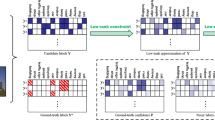Abstract
Partial multi-label learning (PML) aims to learn from the training data where each training example is annotated with a candidate label set, among which only a subset is relevant. Despite the success of existing PML approaches, a major drawback of them lies in lacking of robustness to noisy side information. To tackle this problem, we introduce a novel partial multi-label learning with noisy side information approach, which simultaneously removes noisy outliers from the training instances and trains robust partial multi-label classifier for unlabeled instances prediction. Specifically, we first represent the observed sample set as a feature matrix and then decompose it into an ideal feature matrix and an outlier feature matrix by using the low-rank and sparse decomposition scheme, where the former is constrained to be low rank by considering that the noise-free feature information always lies in a low-dimensional subspace and the latter is assumed to be sparse by considering that the outliers are usually sparse among the observed feature matrix. Secondly, we refine an ideal label confidence matrix from the observed label matrix and use the graph Laplacian regularization to constrain the confidence matrix to keep the intrinsic structure among feature vectors. Thirdly, we constrain the feature mapping matrix to be low rank by utilizing the label correlations. Finally, we obtain both the ideal features and ground-truth labels via minimizing the loss function, where the augmented Lagrange multiplier algorithm and quadratic programming are incorporated to solve the optimization problem. Extensive experiments conducted on ten different data sets demonstrate the effectiveness of our proposed method.





Similar content being viewed by others
Explore related subjects
Discover the latest articles and news from researchers in related subjects, suggested using machine learning.References
Boutell M, Luo J, Shen X, Brown C (2004) Learning multi-label scene classification. Pattern Recogn 37(9):1757–1771
Cabral R, De la Torre F, Costeira JP, Bernardino A (2014) Matrix completion for weakly-supervised multi-label image classification. IEEE Trans Pattern Anal Mach Intell 37(1):121–135
Cai J, Candès E, Shen Z (2010) A singular value thresholding algorithm for matrix completion. SIAM J Optim 20(4):1956–1982
Chiang K, Hsieh C, Dhillon I (2015) Matrix completion with noisy side information. In: Advances in neural information processing systems, pp 3447–3455
Demšar J (2006) Statistical comparisons of classifiers over multiple data sets. J Mach Learn Res 7(1):1–30
Diplaris S, Tsoumakas G, Mitkas P, Vlahavas I (2005) Protein classification with multiple algorithms. In: Panhellenic conference on informatics, pp 448–456
Duygulu P, Barnard K, Freitas J, Forsyth D (2002) Object recognition as machine translation: learning a lexicon for a fixed image vocabulary. In: European conference on computer vision, pp 97–112
Fang J, Zhang M (2019) Partial multi-label learning via credible label elicitation. In: AAAI conference on artificial intelligence, pp 3518–3525
Feng L, An B (2018) Leveraging latent label distributions for partial label learning. In: International joint conference on artificial intelligence, pp 2017–2113
Feng L, An B (2019) Partial label learning by semantic difference maximization. In: International joint conference on artificial intelligence, pp 2294–2300
Feng S, Lang C (2018) Graph regularized low-rank feature mapping for multi-label learning with application to image annotation. Multidimens Syst Signal Process 29(4):1351–1372
Goldberg A, Recht B, Xu J, Nowak R, Zhu X (2010) Transduction with matrix completion: three birds with one stone. In: Advances in neural information processing systems, pp 757–765
Guo Y (2017) Convex co-embedding for matrix completion with predictive side information. In: AAAI conference on artificial intelligence, pp 1955–1961
Han Y, Sun G, Shen Y, Zhang X (2018) Multi-label learning with highly incomplete data via collaborative embedding. In: International conference on knowledge discovery and data mining, pp 1494–1503
Huang D, Cabral R, Dela T (2016) Robust regression. IEEE Trans Pattern Anal Mach Intell 38(2):363–375
Huiskes M, Lew M (2008) The mirflickr retrieval evaluation. In: ACM international conference on multimedia information retrieval, pp 39–43
Ji S, Ye J (2009) An accelerated gradient method for trace norm minimization. In: International conference on machine learning, pp 457–464
Katakis I, Tsoumakas G, Vlahavas I (2008) Multilabel text classification for automated tag suggestion. In: Machine learning and knowledge discovery in databases, pp 5–13
Li Z, Lyu G, Feng S (2020) Partial multi-label learning via multi-subspace representation. In: International joint conference on artificial intelligence
Lin Z, Liu R, Su Z (2011) Linearized alternating direction method with adaptive penalty for low-rank representation. In: Advances in neural information processing systems, pp 612–620
Lyu G, Feng S, Li Y (2020) Noisy label tolerance: a new perspective of partial multi-label learning. Inf Sci 543(8):454–466
Lyu G, Feng S, Li Y (2020) Partial multi-label learning via probabilistic graph matching mechanism. In: ACM SIGKDD conference on knowledge discovery and data mining, pp 105–113
Mencia E, Fürnkranz J (2008) Efficient pairwise multilabel classification for large-scale problems in the legal domain. In: Machine learning and knowledge discovery in databases, pp 50–65
Pestian J, Brew C, Matykiewicz P, Hovermale D, Johnson N, Cohen K, Duch W (2007) A shared task involving multi-label classification of clinical free text. In: Biological, translational, and clinical language processing, pp 97–104
Sun L, Feng S, Wang T, Lang C, Jin Y (2019) Partial multi-label learning by low-rank and sparse decomposition. In: AAAI conference on artificial intelligence, pp 5016–5023
Tsoumakas G, Katakis I, Vlahavas I (2008) Effective and efficient multilabel classification in domains with large number of labels. In: Machine learning and knowledge discovery in databases, pp 53–59
Turnbull D, Barrington L, Torres D, Lanckriet G (2008) Semantic annotation and retrieval of music and sound effects. IEEE Trans Audio Speech Lang Process 16(2):467–476
Wang H, Liu W, Zhao Y, Zhang C, Hu T, Chen G (2019) Discriminative and correlative partial multi-label learning. In: International joint conference on artificial intelligence, pp 3691–3697
Wu J, Wu X, Chen Q, Zhang M (2020) Feature-induced manifold disambiguation for multi-view partial multi-label learning. In: ACM SIGKDD conference on knowledge discovery and data mining, pp 557–565
Xie M, Huang S (2018) Partial multi-label learning. In: AAAI conference on artificial intelligence, pp 4303–4309
Xu M, Jin R, Zhou Z (2013) Speedup matrix completion with side information: application to multi-label learning. In: Advances in neural information processing systems, pp 2301–2309
Xu M, Niu G, Han B, Tsang I, Zhou Z, Sugiyama M (2018) Matrix co-completion for multi-label classification with missing features and labels. arXiv preprint arXiv:1805.09156
Xu N, Liu Y, Geng X (2020) Partial multi-label learning with label distribution. In: AAAI conference on artificial intelligence, pp 6510–6517
Yu G, Chen X, Domeniconi C, Wang J, Li Z, Zhang Z, Wu X (2018) Feature-induced partial multi-label learning. In: International conference on data mining, pp 1398–1403
Yuille A, Rangarajan A (2003) The concave–convex procedure. Neural Comput 15(4):915–936
Zhang M, Wu L (2015) Lift: multi-label learning with label-specific features. IEEE Trans Pattern Anal Mach Intell 37(1):107–120
Zhang M, Zhou Z (2014) A review on multi-label learning algorithms. IEEE Trans Knowl Data Eng 26(8):1819–1837
Zhang Q, Zhong Y, Zhang M (2018) Feature-induced labeling information enrichment for multi-label learning. In: AAAI conference on artificial intelligence, pp. 4446–4453
Zhang X, Ma Y, Lin Z, Gao H, Zhuang L, Yu N (2012) Non-negative low rank and sparse graph for semi-supervised learning. In: IEEE conference on computer vision and pattern recognition, pp. 2328–2335
Zhang Y, Shi D, Gao J, Cheng D (2017) Low-rank-sparse subspace representation for robust regression. In: IEEE conference on computer vision and pattern recognition, pp. 7445–7454
Acknowledgements
This work was supported in part by the National Natural Science Foundation of China (No. 61872032), in part by the Beijing Natural Science Foundation (Nos. 4202058, 9192008, 4202057, 4202060), in part by the Fundamental Research Funds for the Central universities (2018YJS038, 2019JBM020) and in part by the Key R&D Program of Zhejiang Province (No. 2019C01068).
Author information
Authors and Affiliations
Corresponding author
Ethics declarations
Conflict of interest
All the authors certify that there is no conflict of interest with any individual/organization for the present work.
Ethical approval
This article does not contain any studies with human participants or animals performed by any of the authors.
Additional information
Publisher's Note
Springer Nature remains neutral with regard to jurisdictional claims in published maps and institutional affiliations.
Rights and permissions
About this article
Cite this article
Sun, L., Feng, S., Lyu, G. et al. Partial multi-label learning with noisy side information. Knowl Inf Syst 63, 541–564 (2021). https://doi.org/10.1007/s10115-020-01527-3
Received:
Revised:
Accepted:
Published:
Issue Date:
DOI: https://doi.org/10.1007/s10115-020-01527-3




